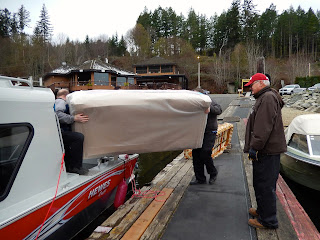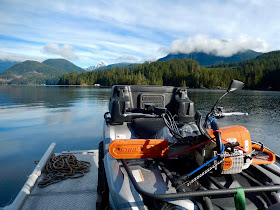
My mother was a crochet expert. I wish I'd taken the time to learn from her, but my life seemed too busy at the time. Now that I'm retired and
live in an off-the-grid float cabin I have plenty of time to learn new skills.
I needed a book for guidance.
Crochet: A Basic Manual for Creative Construction by Mary Tibbals Ventre (Little Brown and Company, 1974) is perfect. It has detailed photographs and easy to follow directions.
 Making Crochet Sofa Armrest Covers
Making Crochet Sofa Armrest Covers
We purchased a sofa in 2013 and brought it up the lake in our boat. Now I've decided to make armrest covers before there's any more wear.
I picked a single crochet pattern involving a circle and a rectangle. Stitched together they form a snug armrest cover.
 Directions for a spiral circle from Crochet by Mary Tibbals Ventre:
Directions for a spiral circle from Crochet by Mary Tibbals Ventre:
Make a foundation chain of three stitches and then make seven single crochets into the third chain stitch from the hook, which is the first stitch of the foundation chain. Mark the completion of the first round.
(I used a small safety pin.) For the next round make two single crochets in each single crochet stitch of the previous round for a total of fourteen stitches. Mark the completion of the round.

For the third round, again make two single crochet stitches in each single crochet stitch of the previous round, for a total of twenty-eight stitches. After these three rounds, fewer increases are needed to keep the circular form flat. The number of increases will vary with the kind of yarn used, hook size and tension. A more or less accurate way of making a larger circular form is to alternate rows of single crochet that are not increased with rows of single crochet that are increased.
Directions for the rectangle:
Make a rectangle large enough to cover the sofa arm. Mine began with 75 chain stitches and then row after row of single crochet. The tricky thing for me was to remember to do an extra chain at the end of each row before turning to maintain the same number of stitches.
Crochet 101 at The Stitchin' Mommy has excellent step by step illustrations.
 Stitching it together:
Stitching it together:
I used a craft needle to weave in the yarn tails where I had to join pieces together. Then I lined up the end of my finished rectangle with the circle and stitched them together with matching yarn. I liked the spiral look of my circle so I chose that for the outside.
The result was a perfect fit. And using single crochet made a thick durable cover to protect the sofa arms from further wear.
Do you crochet? How did you learn? What kinds of things have you made? -- Margy
 Throughout Canada everyone knows about Hockey Night in Canada and its distinctive theme song that was dubbed "Canada's second national anthem." However, when CBC lost the rights it had a contest for a replacement.
Throughout Canada everyone knows about Hockey Night in Canada and its distinctive theme song that was dubbed "Canada's second national anthem." However, when CBC lost the rights it had a contest for a replacement.  Come join us for Hockey Night in Powell River. The games are exciting, the food is tasty (love those chips 'n gravy) and see all your friends in the stands. You might even win the 50-50 draw. Can't make the game? Listen live on Powell River's CoastFM 95.7. -- Margy
Come join us for Hockey Night in Powell River. The games are exciting, the food is tasty (love those chips 'n gravy) and see all your friends in the stands. You might even win the 50-50 draw. Can't make the game? Listen live on Powell River's CoastFM 95.7. -- Margy






















